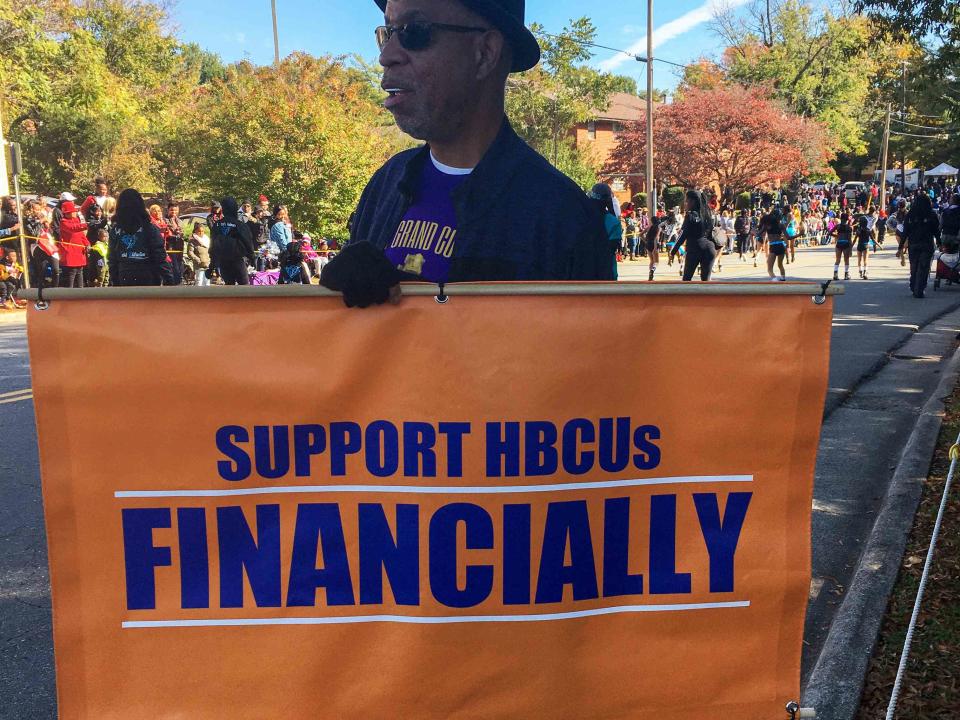HBCUs Are Chronically Underfunded—It's Time That Changed
- Oops!Something went wrong.Please try again later.
HBCU Homecoming season spotlights what we love about Black colleges and universities. It should highlight why states need to invest more in them.

Jasmine Purdie
Six students from Florida Agricultural and Mechanical University (FAMU) have filed a federal lawsuit against the state of Florida. The Florida A&M University students' class action lawsuit is against the board of governors of the State University System, and it claims the historically Black college has been underfunded for decades in violation of Title VI and the 14th amendment.
A Forbes investigation revealed a $1.9 billion shortfall in Florida A&M's funding compared to the state's predominantly white universities. Forbes found that FAMU's $123 million in state appropriations amounted to about $13,000 per student for its enrollment of 9,400 in 2020. That funding falls short of the University of Florida's $15,600 state funding per student in predominantly white universities.
Related:
The students' complaint alleges that funding being held back from FAMU since the late 1980s is over $1.3 billion. The lawsuit seeks for FAMU to reach parity with Florida's majority white universities.
"It's unfortunate that HBCUs have to file lawsuits to fight for the money that's rightfully theirs, but in light of the legal victory that Coppin State, Morgan State, Bowie State, and UMES received, I think we can expect to see more of these lawsuits," says Claudia Walker, Founder of HBCU Prep School, former Wall Street analyst, and author of the best-selling book series The ABCs of HBCUs. Walker is also a graduate of Spelman College.
HBCUs Are Systemically Underfunded
Florida A&M University is just one example of widespread underfunding for HBCUs. America's 100 HBCUs have been underfunded for decades. Data shows that between 1987 and 2020, 18 land-grant HBCUs were underfunded to the tune of $12.8 billion (adjusted for inflation).
In the example of FAMU, underfunding has left students at the HBCU with room shortages, pest infestations, student athletes facing ineligibility, and the athletics department's incomplete staff, the attorney for the students told USA Today.
This underfunding leads to sacrifices needing to be made by students that choose a Black college. On top of that these schools have to deal with bomb threats and racism-related injustices.
Land-grant schools in the U.S.—Black or white—were created to develop and foster agricultural research. Most land-grant universities receive annual funding from state legislatures in a single lump sum. State legislatures have underfunded HBCUs for decades.
One glaring example is when the North Carolina legislature appropriated NC A&T (an HBCU) $95 million, $8,200 less per student than the $16,400 (per student) it allowed N.C. State. Three public HBCUs in Mississippi won a $500 million settlement from the state in 2002. The schools pursued a funding lawsuit that took 27 years and was ultimately decided by the U.S. Supreme Court.
Black Students Deserve Equal Investment
HBCUs make up less than three percent of college institutions. Still, according to the Atlantic, they have educated 80% of Black judges, 50% of Black lawyers and doctors, and 25% of Black science, technology, engineering, and math graduates. HBCUs are changing lives and breaking generational trauma for Black families.
Systematic inequality has also kept HBCUs graduates from making money predominately white-university graduates make. This leads to fewer endowments for HBCUs, as colleges build endowments through alumni donations. In 2020, for example, the average endowment at the 18 white land-grant schools was $1.9 billion, while it was $34 million at HBCUs.
Black graduates don't have access to the same resources and job opportunities, which leads to fewer opportunities to donate extra income. Smaller endowments reduce available resources such as faculty salaries, scholarships, research, expansion, and day-to-day operations at HBCUs. HBCU underfunding is also happening because Black institutions pay higher rates than white universities to borrow money, which affects operating budgets and cash flow.
"In recent years, we've seen so much excitement around HBCUs, but students who choose a Black college shouldn't have to accept subpar facilities or fewer research opportunities simply because local politicians chose to divert funds earmarked for HBCUs to other institutions," says Claudia Walker.
That's why it’s especially important that states need to fund HBCUs similarly to predominantly white universities.
Underfunding HBCUs Has Consequences
In an America that's trying to right hundreds of years of treating people of color as less than, it's essential to invest in Black education. More needs to be done for HBCUs.
Some students want to be taught in universities that understand their history and culture and are committed to seeing people of color thrive. These institutions should be fairly funded.
When HBCUs are underfunded, it has consequences for Black families and future generations of color. It should not take lawsuits for states and the federal government to offer HBCUs the same benefits and opportunities.
false

